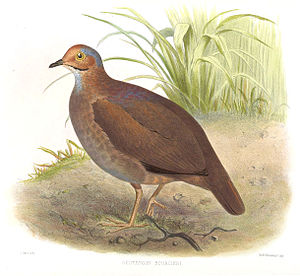Peru quail pigeon
| Peru quail pigeon | ||||||||||
|---|---|---|---|---|---|---|---|---|---|---|

Peruvian quail pigeon ( Geotrygon frenata ) |
||||||||||
| Systematics | ||||||||||
|
||||||||||
| Scientific name | ||||||||||
| Geotrygon frenata | ||||||||||
| ( Tschudi , 1843) |
The Peruvian quail pigeon ( Geotrygon frenata , syn .: Zentrygon frenata ), also called pink-faced quail pigeon , is a species of pigeon birds. This is the largest species within the American earth pigeon genus . It occurs exclusively in South America. Its existence is not considered to be endangered.
Appearance
The Peruvian quail pigeon reaches a body length of up to 33 centimeters. It is a large, long-tailed and compactly built earth pigeon, the size of which corresponds to the dagger -pigeon . It is, however, a bit more leggy. Gender dimorphism does not exist.
The face and forehead are mauve-pink. The top of the head is gray. Two black narrow stripes run through the face. A strip runs from the base of the beak over the eye to the neck. Another below from the cheek to the ear patches. The neck, the back and the wing covers are dark red-brown. The coat is purple-red. The wings of the hand are dark olive brown. The breast is brownish gray. The belly and the under tail-coverts are strong yellow-brown. The iris is reddish brown. The beak is dark gray to black. The feet are reddish.
distribution and habitat
The distribution area extends in a narrow band over the west of South America. This runs from Colombia via Ecuador, Peru and Bolivia. The species occurs on both sides of the central Andes. The habitat are moist, primary mountain forests at altitudes between 1,500 and 2,300 meters above sea level. Occasionally it occurs at altitudes above 900 meters. The species is dependent on largely intact undergrowth and is sensitive to occasional logging.
Way of life
The Peruvian quail pigeon is a resident bird. It is a generally shy and inconspicuous pigeon that runs into the thick undergrowth rather than flies up, even when threatened. She lives mostly singly or in pairs. She looks for food exclusively on the ground. The food spectrum consists of seeds and small fruits as well as probably insects and their larvae. The breeding time varies depending on the area of distribution.
The courtship takes place on the ground. The male first pursues the female, then crouches to the ground when he has caught up with her by buckling his heels. The male then ruffles its rump plumage and makes deep, humming sounds with its closed beak. With his breeding pairs, the owner Alois Münst was able to observe another courtship gesture, which is unusual for pigeons. A male standing on a branch kept lifting one leg and tapping it roughly on the wood. The tail was beaten up and down, the tail being spread in the downward phase.
The clutch consists of two eggs. The incubation period is 14 days. The young birds fledge after 19 to 20 days.
Keeping in human care
A total of 13 specimens of the Peruvian quail pigeon came to Germany and Belgium from 1974 to 1984. The first breeding in Germany took place in 1979 by the wild pigeon expert Alois Münst.
supporting documents
Individual evidence
literature
- David Gibbs, Eustace Barnes and John Cox: Pigeons and Doves - A Guide to the Pigeons and Doves of the World . Pica Press, Sussex 2001, ISBN 90-74345-26-3
- Alois Münst and Josef Wolters: Tauben - The types of wild pigeons , 2nd expanded and revised edition, Verlag Karin Wolters, Bottrop 1999, ISBN 3-9801504-9-6
- Gerhard Rösler: The wild pigeons of the earth - free living, keeping and breeding . Verlag M. & H. Schaper, Alfeld Hannover 1996, ISBN 3-7944-0184-0
Web link
- Zentrygon frenata inthe IUCN 2013 Red List of Threatened Species . Listed by: BirdLife International, 2012. Retrieved January 4, 2014.